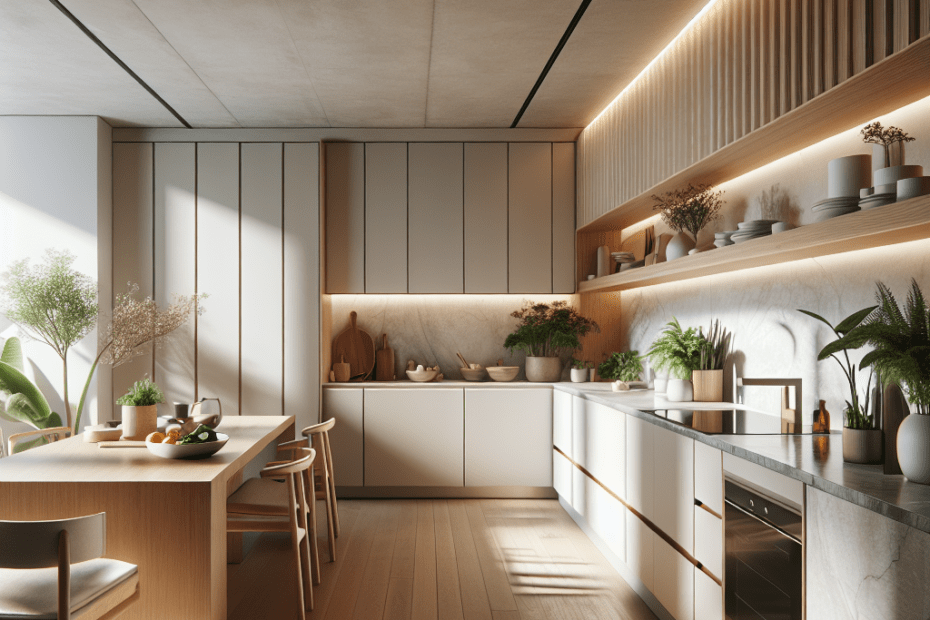Embracing Minimalism in the Kitchen
Many homeowners are choosing to transform their kitchens into serene, clutter-free spaces by embracing minimalism. Using natural materials, one can create a minimalist kitchen that is not only visually appealing but also environmentally friendly. By focusing on sustainable choices, they contribute to a home that is healthy for both the residents and the planet.
The Beauty of Natural Materials
Natural materials, like wood, stone, and metal, offer a timeless beauty that synthetic materials cannot replicate. They bring warmth, texture, and an organic element that complements the minimalist aesthetic. When selecting materials, many opt for FSC-certified wood to ensure responsible sourcing. According to a report from the Forest Stewardship Council, the demand for FSC-certified products has increased by 20% in recent years, illustrating the growing trend of sustainability.
Key Elements of a Minimalist Kitchen
For those looking to achieve a minimalist kitchen with natural materials, several key elements are essential.
- Simplicity in Design: Opt for clean lines and a neutral color palette. Whites, greys, and earth tones are ideal for creating a calm environment.
- Efficient Storage: Limiting clutter is vital. Use built-in cabinets and shelving to keep countertops clear, and choose efficient storage solutions that hide away daily essentials.
- Quality Over Quantity: Invest in fewer, higher-quality items. Durable natural materials may be more expensive initially but provide long-term value and sustainability.
Choosing the Right Natural Materials
When designing a minimalist kitchen, they should carefully choose materials that align with their aesthetic and functional needs.
| Material | Characteristics |
|---|---|
| Wood | Warm, inviting, versatile in finish |
| Stone | Durable, natural patterns, cool to touch |
| Metal | Sleek, reflective, easy to maintain |
Incorporating Natural Materials Effectively
Integration is key; from countertops to flooring, they should aim for harmony. Wooden cabinets, stone floors, and metal hardware work together to create a cohesive look. They often consider live-edge wood for countertops to enhance the natural appeal.
Sustainable Living and Health Benefits
The benefits of using natural materials extend beyond aesthetics. These materials are typically free from harmful chemicals and contribute to better indoor air quality. The use of these elements aligns with the principles of biophilic design, which posits that humans have an innate tendency to seek connections with nature. According to a study published on ScienceDirect, homes incorporating natural elements report a 23% increase in occupant well-being and comfort.
Key Takeaways
- Minimalist kitchens focus on simplicity and functionality using natural materials.
- Wood, stone, and metal are prime choices due to their durability and aesthetic appeal.
- Opt for sustainable options like FSC-certified wood to promote environmental responsibility.
- Efficient storage and a neutral color palette are crucial for maintaining a minimalist look.
- Natural materials improve air quality and enhance the well-being of residents.
FAQs
- What is a minimalist kitchen?
- A minimalist kitchen uses clean lines, a neutral palette, and essential items to create an uncluttered space focused on simplicity and functionality.
- Why choose natural materials for the kitchen?
- Natural materials offer durability, aesthetics, and sustainability compared to synthetic options. They enhance well-being by improving indoor air quality.
- How can one maintain a minimalist kitchen?
- Keep surfaces clear of clutter, invest in quality storage solutions, and regularly declutter to maintain a tidy, minimalist space.
- What are the best natural materials for a minimalist kitchen?
- Wood, stone, and metal are excellent choices due to their durability, aesthetic appeal, and sustainability.
- How does a minimalist kitchen improve well-being?
- This kitchen style reduces clutter and uses natural elements, which contribute to a calm, organized environment enhancing mental well-being.
